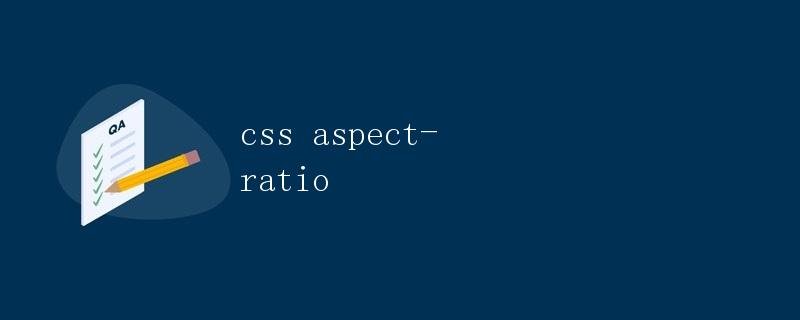CSS aspect-ratio
CSS aspect-ratio

In web development, sometimes we need to control the aspect ratio of elements, which is particularly useful in responsive design and multimedia presentation. CSS doesn’t natively have a property for controlling aspect ratio, but aspect-ratio makes it easy to do so.
What is aspect-ratio?>
aspect-ratio is a new CSS property that defines an element’s aspect ratio. This property ensures that the element’s aspect ratio remains constant even when the content changes. This is particularly useful in responsive design and multimedia presentations.
How to Use aspect-ratio
Basic Usage
aspect-ratio property can be defined using the format aspect-ratio: width / height; , where width and height represent the width and height of the element, respectively. For example, if we want an element with an aspect ratio of 16:9, we can write:
.aspect-ratio-box {
aspect-ratio: 16 / 9;
}
Percentage Values
aspect-ratio can also be defined using percentage values. For example, if we want an element to be twice as wide as it is tall, we can write it like this:
.aspect-ratio-box {
aspect-ratio: 200% / 100%;
}
Support auto
In some cases, we may want an element’s aspect ratio to automatically adapt to the size of its content. To do this, set aspect-ratio to auto to have the element automatically adjust its aspect ratio based on its content. For example:
.aspect-ratio-box {
aspect-ratio: auto;
}
Complex Usage
In addition to basic aspect ratios, aspect-ratio also supports calculated aspect ratios and normal numerical calculations. For example, if we want an element with a width of 100px and a height that is 1.618 times its width, we can write it like this:
.aspect-ratio-box {
aspect-ratio: 100px / 1.618;
}
Practical Applications
Horizontal Alignment
In web design, multiple elements are often arranged horizontally. Using aspect-ratio can better control the aspect ratio of these elements and maintain the stability of the overall layout.
<div class="container">
<div class="aspect-ratio-box"></div>
<div class="aspect-ratio-box"></div>
<div class="aspect-ratio-box"></div>
</div>
.container {
display: flex;
}
.aspect-ratio-box {
flex: 1;
aspect-ratio: 16 / 9;
background-color: lightblue;
margin: 10px;
}
Responsive Design
In responsive design, a page’s layout dynamically adjusts to different screen sizes and device types. Use aspect-ratio to ensure that an element maintains a consistent aspect ratio across screen sizes.
@media screen and (max-width: 600px) {
.aspect-ratio-box {
aspect-ratio: 4/ 3;
}
}
@media screen and (min-width: 601px) and (max-width: 1200px) {
.aspect-ratio-box {
aspect-ratio: 16 / 9;
}
}
@media screen and (min-width: 1201px) {
.aspect-ratio-box {
aspect-ratio: 2 / 1;
}
}
Compatibility
As of early 2022, the aspect-ratio property is highly compatible and supported by all major browsers. However, to ensure optimal compatibility, it’s recommended to check the Mozilla Developer Network (MDN) for the latest compatibility information when using this feature.
Conclusion
The
aspect-ratio property provides a simple and convenient way to control the aspect ratio of an element, making it particularly useful in responsive design and multimedia presentations.